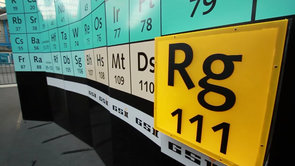Discovery of new elements
In experiments at the GSI accelerator facility scientists succeeded in finding the elements 107 to 112.
Chemical elements are produced in stars and stellar explosions. They are the fabric that forms all the matter around us – even in our bodies. Several elements occur in space even though they can't be found on earth.
The scientists at GSI try to produce new and so far unknown elements in the laboratory. The ones discovered so far are unstable and mostly decay after a short time. However, theoretical calculations predict a so called island of stability. It denominates elements that might have very long lifetimes. To find this island of stability is a goal of the scientists.
Besides the discovery of the elements 107 to 112 GSI also succeeded in the production of the elements 113 to 117 and thus verified data from Japanese and Russian discoveries.
- Elements discovered at GSI (atomic number): bohrium (107), hassium (108), meitnerium (109), darmstadtium (110), roentgenium (111), copernicium (112)
- GSI participated in element discovers: nihonium (113), flerovium (114), moscovium (115), livermorium (116), tennessine (117)
Background
International Year of the Periodic Table
Elements made at GSI
Atomic Number | Name (Symbol) | Origin of name | Date of Discovery** | First produced from | Date of offical recognition* | Discovering laboratory |
|---|---|---|---|---|---|---|
107 | Bohrium (Bh) | Niels Bohr, Danish physicist, Nobel prize winner 1922, development of the Bohr atomic model | February 24, 1981 | Chrome, Bismuth | December 1997 | GSI, Darmstadt, Germany |
108 | Hassium (Hs) | German State of Hesse, location of GSI | March 14, 1984 | Lead, Iron | December 1997 | GSI, Darmstadt, Germany |
109 | Meitnerium (Mt) | Lise Meitner, Austrian physicist, theoretical description of nuclear fission | August 29, 1982 | Bimuth, Iron | December 1997 | GSI, Darmstadt, Germany |
110 | Darmstadtium (Ds) | Darmstadt, location of GSI | November 9, 1994 | Lead, Nickel | August 2003 | GSI, Darmstadt, Germany |
111 | Roentgenium (Rg) | Wilhelm Conrad Röntgen, German physicist, Nobel prize winner 1901, discovery of the x-rays | December 8, 1994 | Nickel, Bismuth | November 2004 | GSI, Darmstadt, Germany |
112 | Copernicium (Cn) | Nikolaus Kopernikus, astronomer of the 15/16 century, theoretical description of the heliocentric system | February 9, 1996 | Zinc, Lead | February 2010 | GSI, Darmstadt, Germany |
Elements 113 – 118
Announcing the finding of an element is not enough for an institute to get official recognition of the element.
Atoms of the new element are not directly observed, but scientists measure their decay chains. Other accelerator facilities, apart from GSI for example in Russia, Japan and the USA, try to produce atoms of the new element as well. They check whether their decay chains match the previously observed ones. If they succeed IUPAC will after a thorough audit officially recognize the discovery.
Atomic number | Name (Symbol) | Origin of name | Date of discovery*** | Date of official recognition* | Date of production at GSI | Discovering laboratory |
|---|---|---|---|---|---|---|
113 | Nihonium (Nh) | Nihon is one of the two ways to say “Japan” in Japanese, and means “the Land of Rising Sun” | February 2004 | November 2016 | November 7, 2012 | RIKEN, Wako, Japan |
114 | Flerovium (Fl) | Georgy Nikolayevich Flyorov (Flerov), Russian physicist, discoverer of spontaneous nuclear fission | July 1999 | June 2011 | June 2, 2009 | JINR, Dubna, Russia |
115 | Moscovium (Mc) | In recognition of the Moscow region which is the home of JINR | February 2004 | November 2016 | November 7, 2012 | JINR, Dubna, Russia |
116 | Livermorium (Lv) | Named after the US laboratory LLNL in Livermore which participated in the discovery | January 2001 | June 2011 | July 2, 2010 | JINR, Dubna, Russia |
117 | Tennessine (Ts) | In recognition of the Tennessee region, as laboratories and universities from there participated in the discovery | April 2010 | November 2016 | September 28, 2012 | JINR, Dubna, Russia |
118 | Oganesson (Og) | Yuri Oganessian, Russian physicst and discoverer of elements | October 2006 | November 2016 | -- | JINR, Dubna, Russia |
(Status: December 2016)
* specified is the date of official recognition of the name by IUPAC (International Union of Pure and Applied Chemistry). The procedure for recognition has several stages: 1) A workgroup of IUPAC and IUPAP (International Union of Pure and Applied Physics) recognizes the existence of the element (verification) and asks the discovering scientists to propose a name. 2) The discovering scientists propose a name. 3) IUPAC publishes the name for five month to be debated in public. 4) Under consideration of the results IUPAC decides for a name, if necessary with modifications to the original proposal of the scientists.
** specified is the date of the first experimental proof (recognized by IUPAC) of the element.
*** specified is the date of the first publication in a scientific journal.













